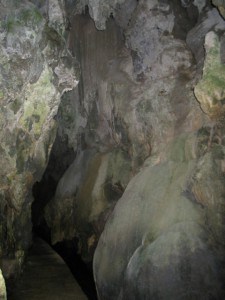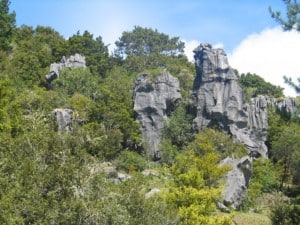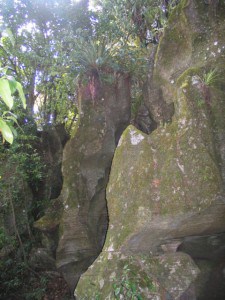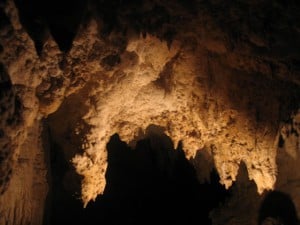[vc_row][vc_column][vc_column_text]
Waiomio has spectacular glow-worm caves, grand limestone formations and is the ancestral land of the Ngati Hine people whose ancestor designed Ruapekapeka Pa
[/vc_column_text][/vc_column][/vc_row][vc_row][vc_column width=”1/3″][vc_custom_heading text=”General Information” font_container=”tag:h2|text_align:center”][vc_column_text]The small Māori settlement of 6Waiomio lies in a valley four kilometres south of 2 Kawakawa, on State Highway 1 (SH1). The Marae on SH1 (left side travelling north) is the land mark which tells you that you are in Waiomio as there aren’t any shops or distinctive signs of a town.
Waiomio Road; opposite the Marae is well signposted and as you travel down this road you will cross Waiomio Stream. Within a couple of minutes you will see a landscape etched strikingly with grand limestone formations and be shown the way to caves which is 1km from the SH1 turnoff. The property which the caves are on is owned by the 3Kawiti Whanau (family) who are the 1kiatiaki (guardians) of the Kawiti Glow Worm Caves.

The entrance to Kawiti Caves has impressive limestone walls and leads onto a boarded walkway.
Waiomio Far North 2 of 4
Maori Translations
1Katiaki: guardians, keepers, and protectors.
2Kawakawa: name for the aromatic shrub that can grow up to 6m tall. Derived from “kawa” meaning sour and bitter, which is the taste of the brewed Kawakawa leaves.
3Kawiti: taper or dwindle.
4Ruapekapeka: “The bat’s nest”; rua: hole; pekapeka: native bat.
5Tapu: forbidden; sacred.
.
6Waiomio: “meandering waters”.
[/vc_column_text][/vc_column][vc_column width=”1/3″][vc_column_text]
 Waiomio Limestone Formations
Waiomio Limestone Formations
The limestone formations are a striking feature of the landscape of Waiomio.
Waiomio Far North 3 of 4
Glow Worm
Caves, rivers banks and other shady crevices provide a home for New Zealand’s most famous fly; the glow-worm (Arachnocompa luminosa) belonging to the gnat family and is not related to the European glow-worm which is a beetle.The glow-worm uses its glow to attract insects. The insects fly towards the glow and get stuck in the sticky strands that the glow-worm makes like a spiders web. The glow is also used to deter creatures from eating it. Starting as an egg, the glow-worm hatches into lava, turns into a pupa in a cocoon and then into a tiny fly.
Acknowledged forms of spelling; glow-worm, glow worm and glowworm.

Limestone Pillars
Limestone pillars in the bush of Kawiti Scenic Walk area. Waiomio Far North 1 of 4
[/vc_column_text][/vc_column][vc_column width=”1/3″][vc_column_text]
Attractions and Activities
The main attraction is the spectacular Kawiti Glow- worm Caves. The caves presents a galaxy of glow-worm lights, impressive limestone walls and magnificent delicate stalactites and stalagmites that took thousands of years to form. A small stream flows through the cave in which a pet eel resides, and can be stroked.

Stalagmites Kawiti Caves
The stalagmite formations inside Kawiti Glow-worm Caves are magnificent.
Waiomio Far North 4 of 4
Only small groups are taken on the guided cave tours at any one time and all questions are skilfully answered. The informative narration from your guide comes with what you will find is uniquely Māori humour which causes outbreaks of laughter and mirth. A few of the naturally shaped stalactites and stalagmites, aptly fuelled by your guide, will create hilarity which socially enhances your experience. Although the caves don’t have huge caverns like Waitomo they are still impressive and truly worth while visiting.The unguided 10minute Scenic Walk from the caves to the excellent car park is easy, tranquil, and enjoyable and can be spiritual. You will pass through native bush where the limestone formations appear as pillars, boulders and huge solid slabs. Some shapes look very similar to furniture and others look as if they were inspirational for some of Weta Workshop creations.
Take your time; explore, look through crevices and down holes. Sit and allow your senses to take in the surroundings and you may be touched with the spiritually that emanates from here making you feel one with the land as you hear bird songs.
The remains of the massive 4 Ruapekapeka Pa site is a few minutes south from Waiomio and is worthy of a visit to appreciate the history of Waiomio Valley and its people the Ngati Hine.
The township of Kawakawa is a five minute drive north and the Bay of Islands can be reached within 30 minutes.
[/vc_column_text][/vc_column][/vc_row][vc_row][vc_column][vc_column_text]
History
Waiomio Valley is the ancestral land and heart of the Ngati Hine people. The Ngati Hine have lived continuously for centuries in this area and are members of the Ngapuhi tribe.
The Kawiti whanau are descendants of Te Ruki Kawiti a renowned Maori Chieftain known as a peace maker of standing among his own people. He was a formidable warrior favouring rugged terrain as a battle field rather than fighting from a fort and had the distinction of fighting alongside Hongi Hika and Hone Heke. He was also involved in the last battle of the first campaign of the Northern War 1845-1846 against British troops at Ruapekapeka Pa.
Te Ruki Kawiti designed and engineered Ruapekapeka Pa which was a remarkable fortification. It included extra thick Puriri palisades, trenches and underground shelters. No major building was erected within the Pa, underground shelters were built instead. These bunkers held twenty men and were designed to withstand heavy bombardment from British artillery which lasted two weeks. Kawiti with his men sheltered in these dark bunkers similar to a colony of bats which gave the Pa its name. Ruapekapeka meaning the “bats nest”. When the British finally entered they found only a handful of Maori warriors still there. The rest had tactically slipped away. After his death a memorial was erected at Waiomio Caves by his great grandson.
The area around the caves was regarded as 5tapu because of the burial sites in the hills nearby where Ngati Hine ancestor Hineamaru lies surrounded by her descendants.
[/vc_column_text][/vc_column][/vc_row]
